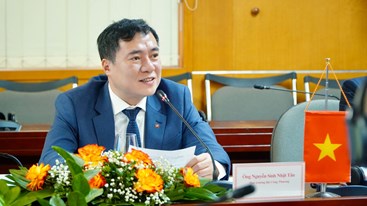Wednesday, 08/05/2024 | 08:52 GMT+7
On December 15th, in Hanoi, the Ministry of Industry and Trade (MOIT) held a ceremony reviewing the energy efficiency program in the 2006-2010 period and the implementation of Directive No. 19/2005/CT-TTg on energy conservation in production and consumption . After 5 years of nationwide deployment, with the coordination between the MOIT and the People's Committees of provinces and cities under the Central Government, the program has obtained encouraging achievements.
From efforts…
In recent years, the MOIT has directed Vietnam Electricity Corporation to balance and ensure electricity supply for socio - economic development, and assigned provinces and cities directly under the Central Government to continue the thorough implementation of Directive No. 19/2005/CT-TTg on energy conservation in production and consumption.
For the industrial production sector, the Ministry has conducted surveys on more than 500 key enterprises and coordinated with consulting units to implement energy audit in over 300 enterprises across the country, supported manufacturing enterprises in upgrading, improving and rationalizing the technological lines to use energy economically and efficiently.

Deputy Minister of Industry and Trade Hoang Quoc Vuong summarizes the experience and success in the energy efficiency program. He also stressed that the localities must boost power saving activities in 2011 - 2015 period
In the 2006 - 2009 period, 17 standards on energy efficiency has been improved to concretize the standards on energy saving performance. Compact bulbs, electronic ballasts, electric fans, street light reflectors, air conditioners, refrigerators and three-phase asynchronous electric motors have been standardized.
Besides the recognition and implementation of energy labelling for products such as T8, T5 fluorescent lights, electronic iron ballasts, compact fluorescent light bulbs, high-efficiency reflectors, the MOIT has supported enterprises in improving the quality of energy saving products and boosted the dissemination of the use of solar water heaters.
…to achieved results
In the 2006-2010 period, provinces and cities have saved 4,039 million kWh, reaching 127% of the plan (about 1.4% of total commercial electricity). Particularly in 2010, about 1,183.91 million kWh is estimated to be saved (142% of the plan), equivalent to 1.41% of commercial electricity.
These figures are especially significant because in recent years, extreme hydrologic conditions and long drought have made it difficult for power supply. In addition, in the 2006 - 2010 period, load output has continued to rise, with a 13.7% increase in annual electricity demand, two times higher than GDP growth. By the end of 2010, average commercial electricity is estimated to be 981 kWh per person per year, 1.8 times as much as in 2005.
Plans for the coming years
The energy efficiency program in the 2006 -2010 period has been successfully implemented and has contributed to reducing the tension of electricity shortage in recent years.
In the near future, power-saving priorities will be concentrated on small and medium businesses, offices, agencies, public business units funded by the budget, commercial buildings.
As directed by the MOIT, Vietnam Electricity Corporation will continue to actively coordinate with localities to effectively implement energy saving activities. Besides, economic groups will also possitively implement energy saving programs to reduce the power consumption per unit of product, certain areas which consume much energy such as steel, cement, mining, shipbuilding, chemical ... will have special attention.
By Minh Duc



.png?w=367&h=206&mode=crop)




.jpg?w=367&h=206&mode=crop) Energy efficiency and conservation usage is an important aspect of the national energy development strategy
05/03/2024
Energy efficiency and conservation usage is an important aspect of the national energy development strategy
05/03/2024
 Challenges and Opportunities to promote energy efficiency market in Vietnam
Challenges and Opportunities to promote energy efficiency market in Vietnam
 The Ministry of Industry and Trade requests government agencies to coordinate in organizing Earth Hour 2024
The Ministry of Industry and Trade requests government agencies to coordinate in organizing Earth Hour 2024
 Consultation on Energy Efficiency Boiler Catalogue and Wood Drying Guideline
Consultation on Energy Efficiency Boiler Catalogue and Wood Drying Guideline
.png?w=367&h=206&mode=crop) Request for expression of interest - C2.1.13: Capacity Building on energy efficiency policies development
Request for expression of interest - C2.1.13: Capacity Building on energy efficiency policies development
 Son Ha Co., Ltd, applies energy efficiency and conservation measures
Son Ha Co., Ltd, applies energy efficiency and conservation measures
 Phuc Kien Co., Ltd., is effectively implementing energy-saving measures
Phuc Kien Co., Ltd., is effectively implementing energy-saving measures
 Request for expression of interest - C2.1.12: Independent monitoring of safeguards implementation
Request for expression of interest - C2.1.12: Independent monitoring of safeguards implementation